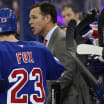Every team now has an analytics person or department to help coaches drill down information to provide more than what's available on any website. For example, teams can determine the breakout success odds for every puck that is dumped in. What is the defensive zone denial rate, which measures how often teams are getting across your blue line with control of the puck or how many times are you denying them?
It gets pretty specific.
You can zero in on passes to the slot and see how many turn into scoring chances as a result. The offensive zone entry metric calculates the percentage of times teams skate across the blue line with possession of the puck. These examples are all part of the bigger picture, but as a new coach you must narrow your focus. Too much information leaves you and your team scattered. If you're not dialed in on the two or three things you want to work on, the message can get lost in a hurry.
Some systematic aspects won't show up in the data.
For example, coaches must determine if their teams need to defend earlier in the neutral zone to allow for less time in the defensive zone. How can they get their defensemen to have better gaps in the neutral zone and their forwards to come back harder so they turn over pucks in the neutral zone as opposed to giving up time in the defensive zone?
Once teams enter the offensive zone, that's a hurdle they can feel good about and subsequently let their creative instincts take over. The Tampa Bay Lightning, for instance, have success because they have the talent level in addition to a structure and system to get the puck over the blue line.
So far this season, breakouts seem to be a focus of the Sabres. In fact, watching them in a 4-0 win against the Dallas Stars on Monday triggered my idea for this story. Their breakouts were strong against Dallas because they used their support system well, meaning when Buffalo's players got congested along the wall, they used their defenseman on the weak side to alleviate that pressure. It was like a fourth man jumping into the offensive play, but they activated him in the defensive zone.
Sabres defensemen Rasmus Dahlin and Rasmus Ristolainen are elite skaters, so a coach wants them with the puck. Forwards were passing to them through the middle of the ice to get out of the pressure points the Stars were trying to create.


















